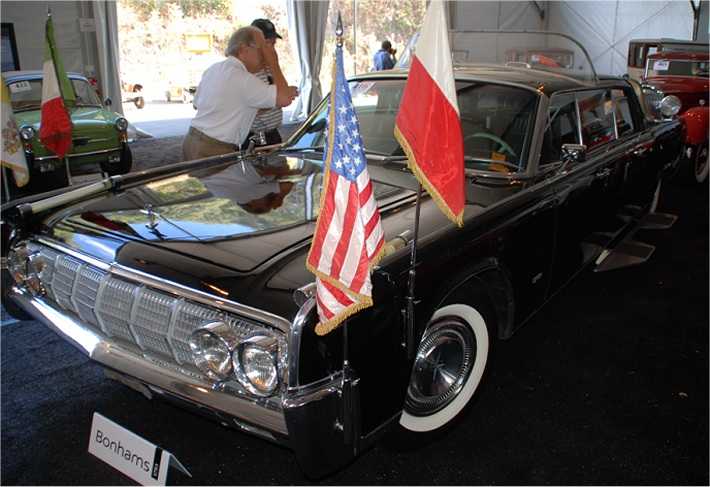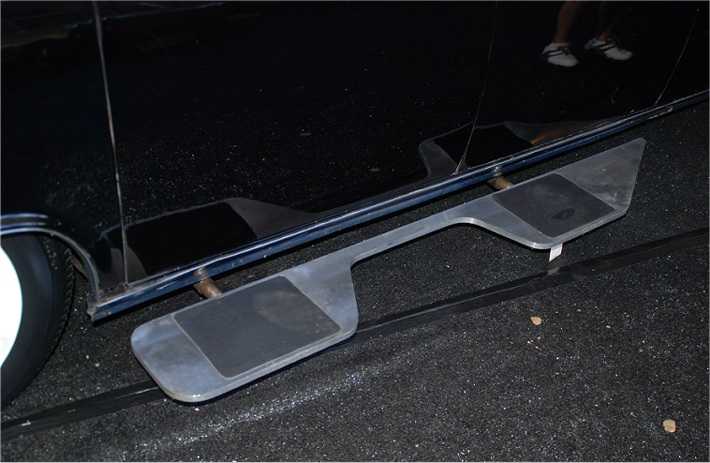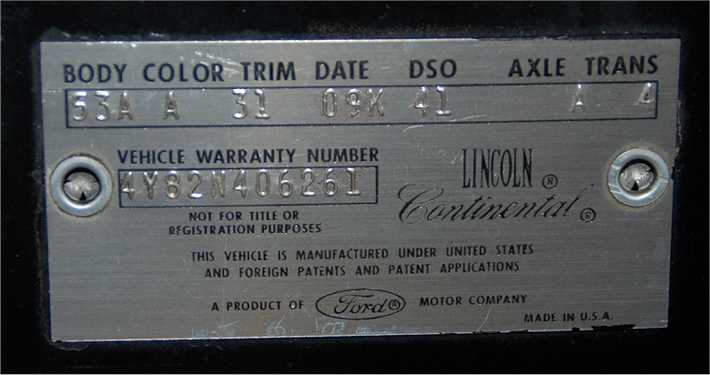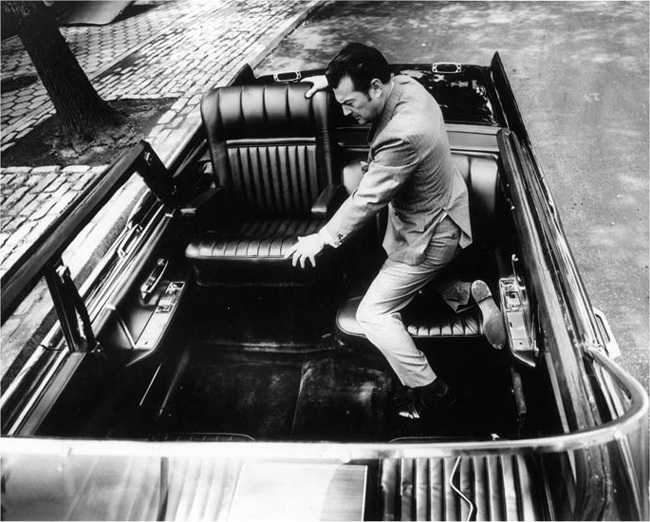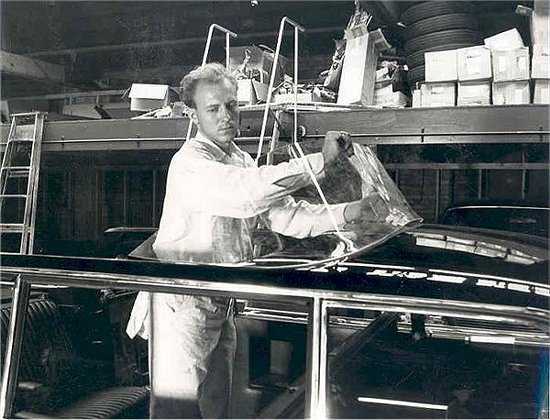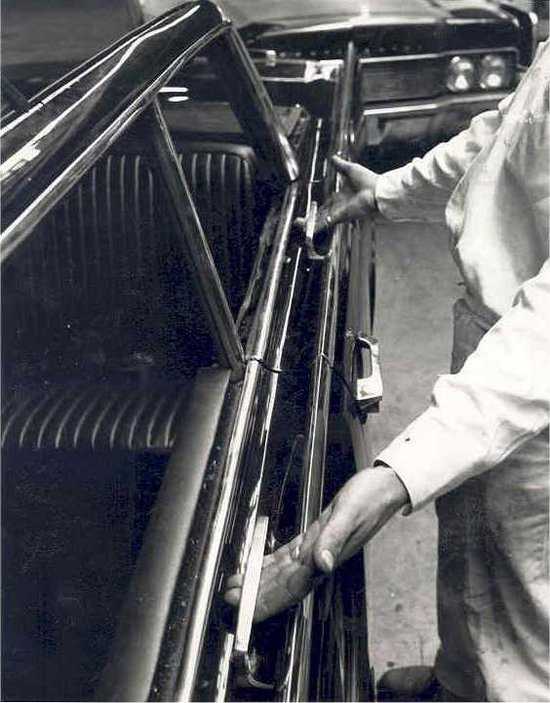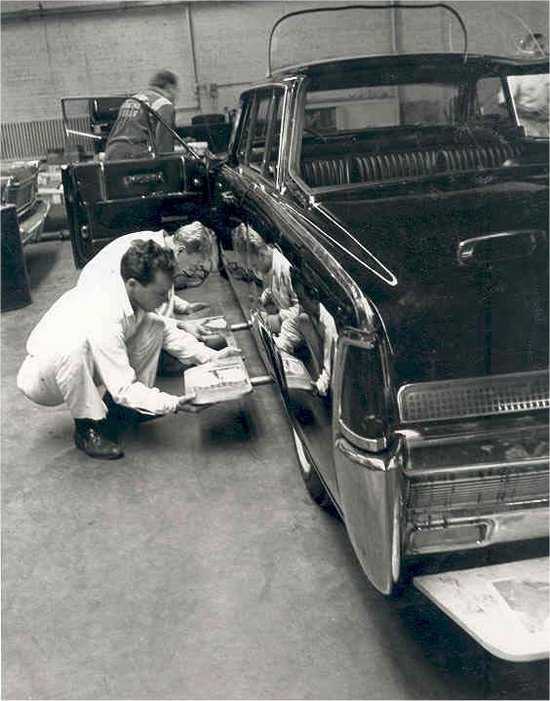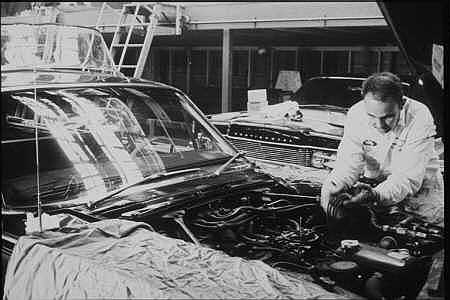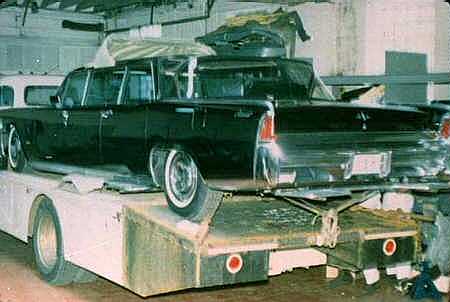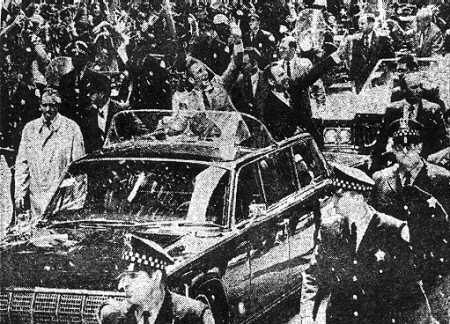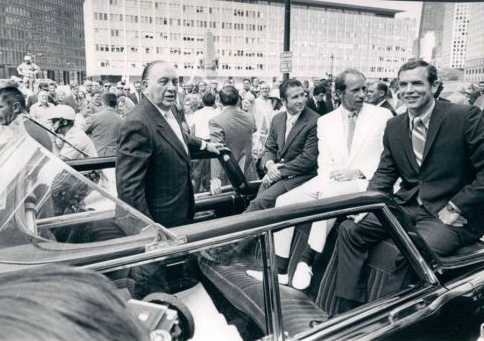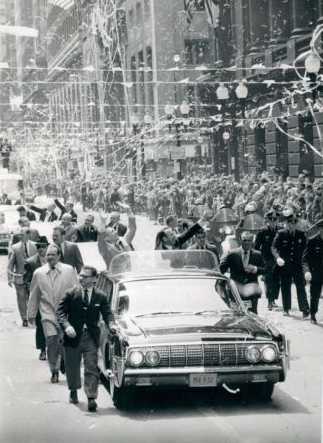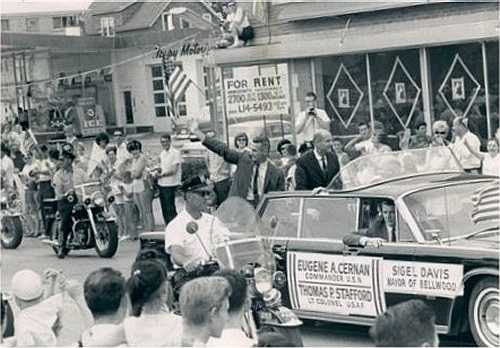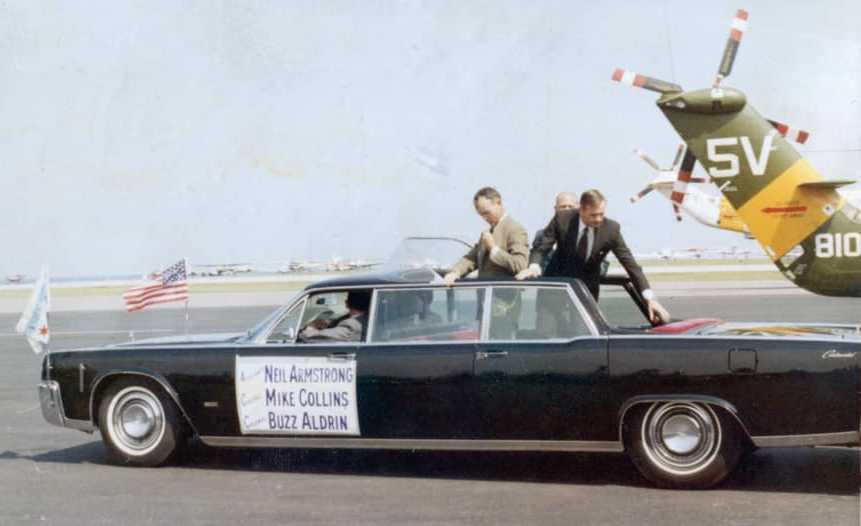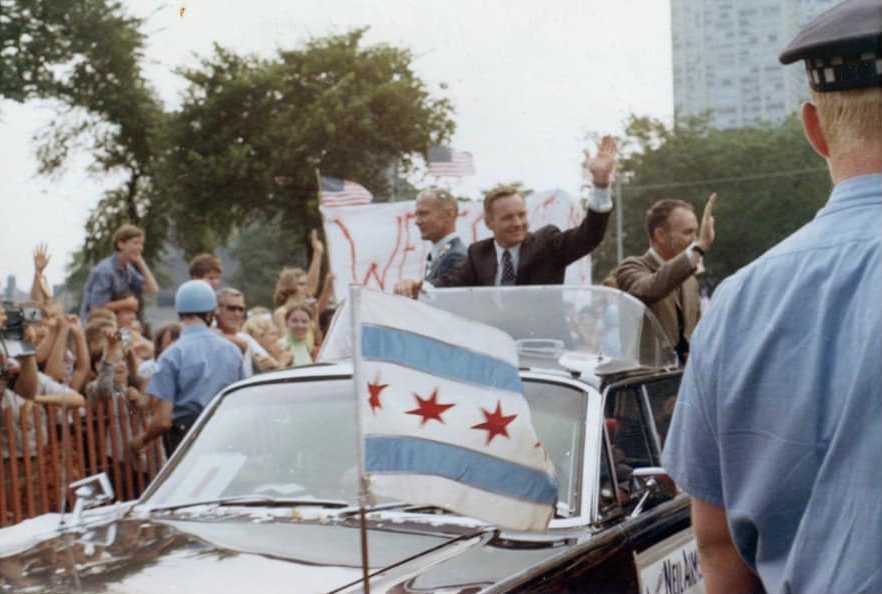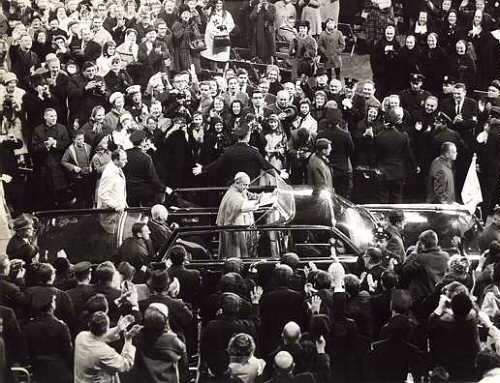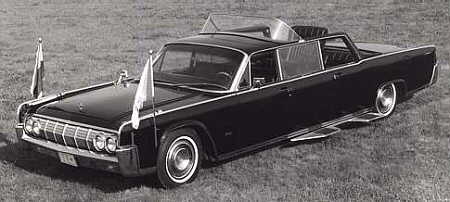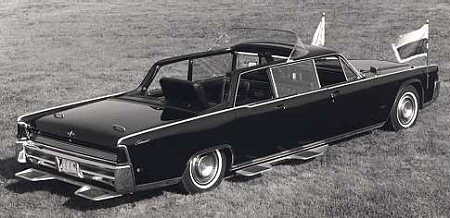"Popemobile"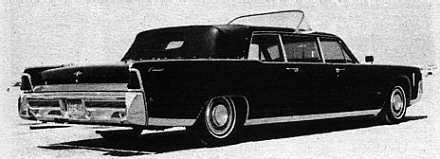 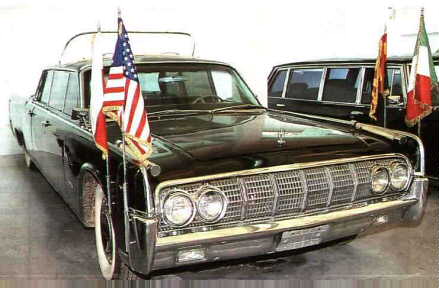 This car has an interesting story as was told by Peterson. It was originally used as test vehicle for Ford and was accidentaly crashed. The front and rear were destroyed but the stretch was intact. Peterson had always wanted to remove part of the roof on a limousine, so now he had the car to do it. The passenger compartment roof was removed, a flying bridge windshield was affixed to the existing roof, and running boards were added. Other modifications included an elevated seat which would raise up 12 inches above the left seat by a handcrank behind the seat, grab handles for security people and both a public address system and flood lights. On October 4, 1965 it was used by Pope Paul VI during a trip to New York. The car was also used by LBJ in Detroit, Hubert Humphrey, as well as most of the astrounauts in parades. |
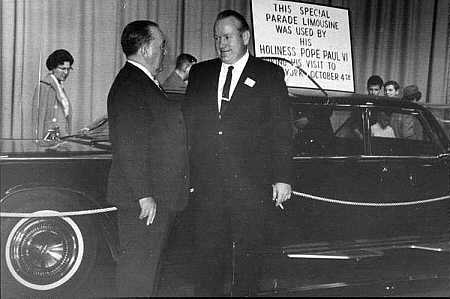
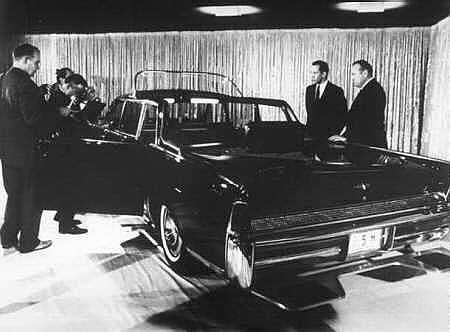
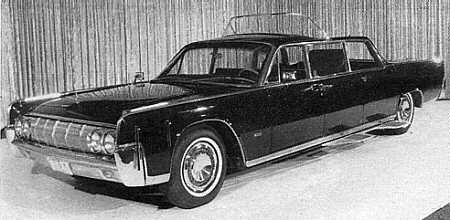
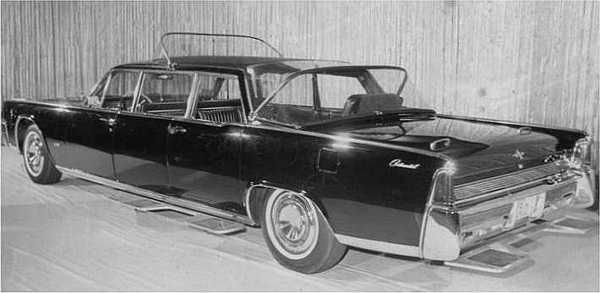
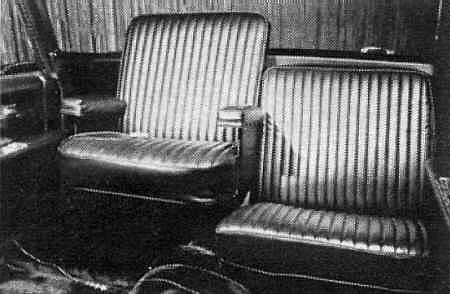
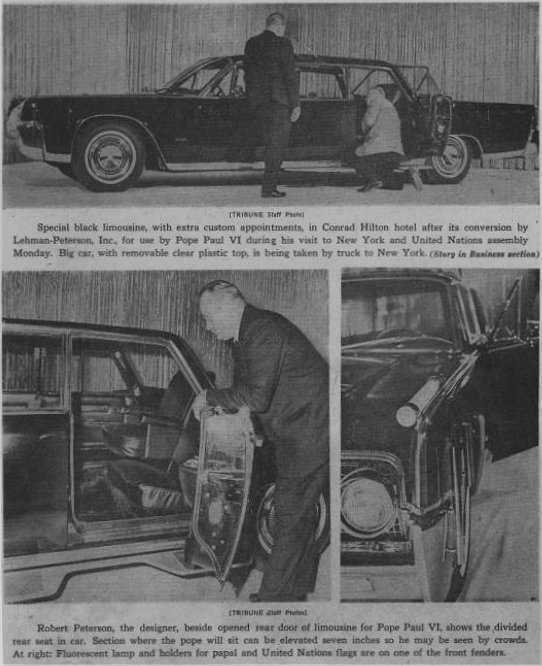
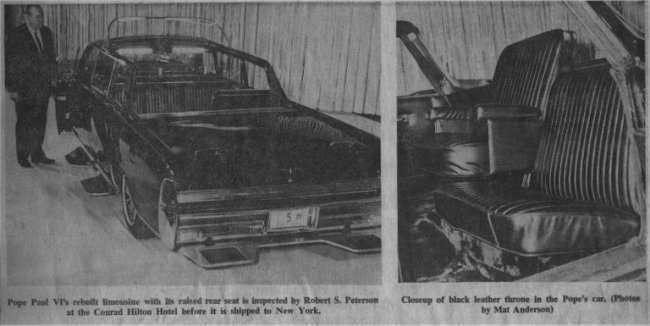
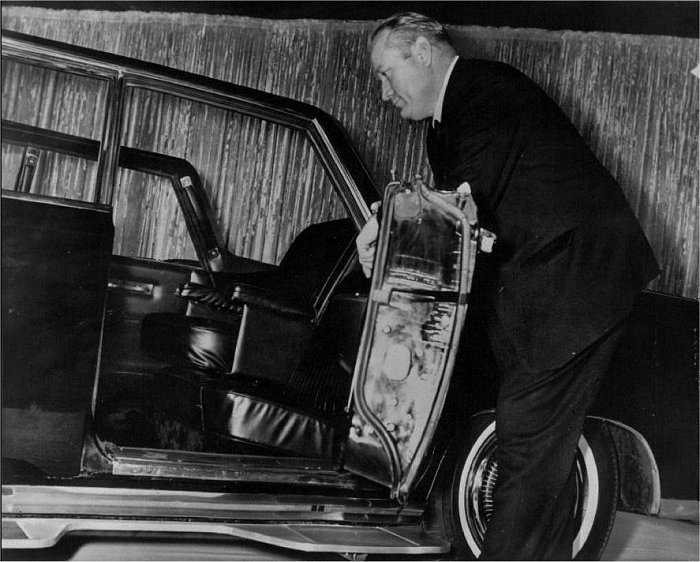
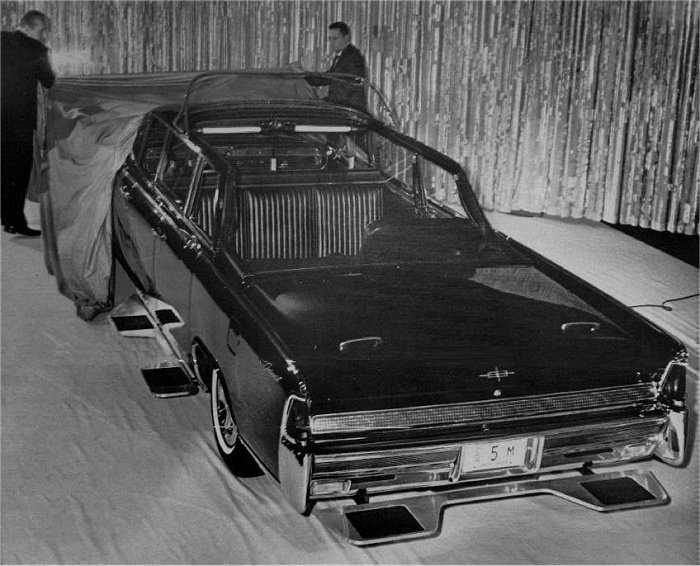
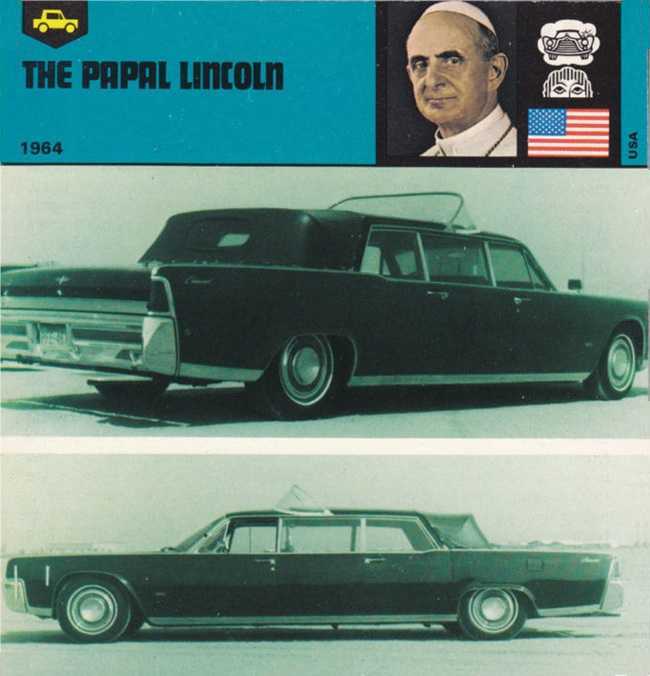
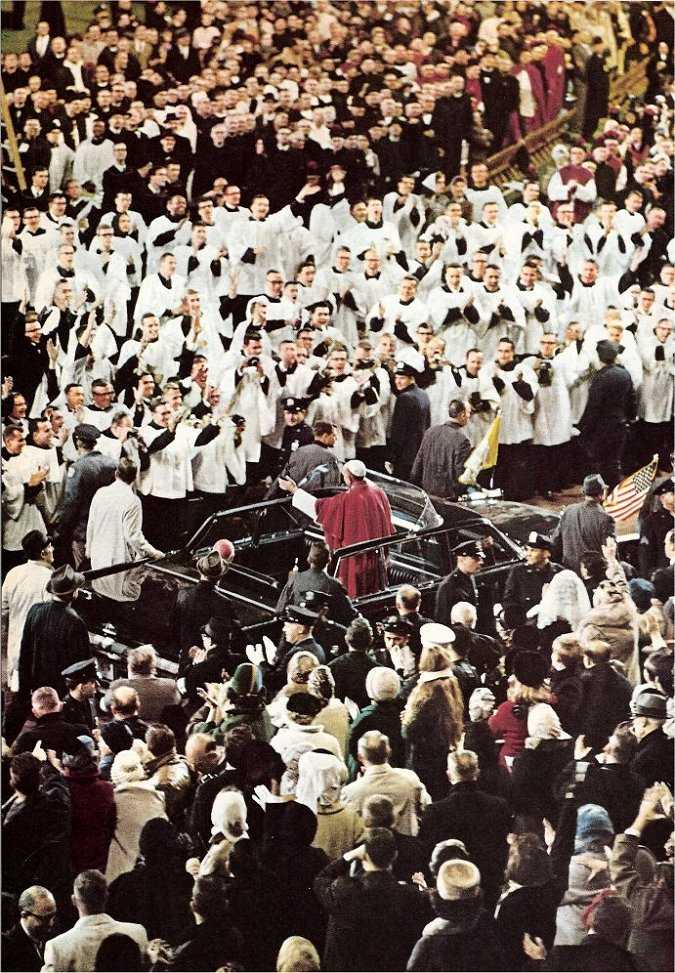
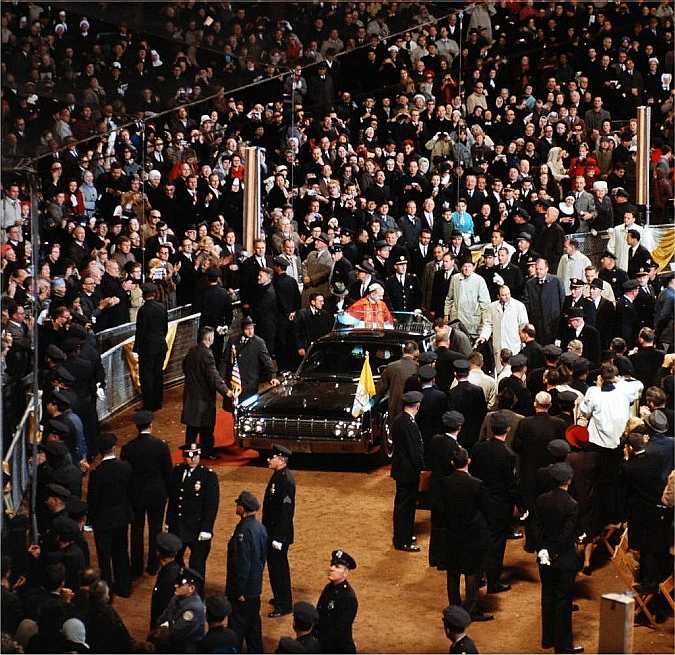
Popal Limousine Press Kit
|
"Time Magazine Article"He was to spend less than a day in the U.S., but every second of the Pope's stay was planned, programmed and protected by harried officialdom. It was, after all, the first American visit by any Pope, and New Yorkers became so excited that the police broadcast hundreds of appeals to them to stay home. Preparations for the day began from the moment on Sept. 9 that Paul VI announced his acceptance of U.N. Secretary-General U Thant's invitation to address the General Assembly. New York City police and FBI men, worried about an assassination attempt, pored through their files on anti-Catholic fanatics, wound up putting potentially dangerous types under surveillance. Detectives made the rounds of clerical supply stores, warned clerks to beware of any suspicious purchasers who might want to masquerade as clergymen. New York's Police Commissioner Warren Broderick groaned that his force would "be taxed to an extent they have never been taxed before," deployed 18,000 of his 26,000 men to cover every inch of the Pope's 24.7-mile route into the city from Kennedy Airport, as well as each point he would visit. Overtime pay for the cops was estimated at $1,000,000. Boards & Bomb Experts. For a man of the Pontiff's age (68), it was a tense and trying ordeal. To ease it, a special 1964 Lincoln Continental limousine was lengthened a full yard (to 20 ft. 10 in.) by a Chicago manufacturer and fitted with running boards so that it could carry 13 people—including six security guards. It was equipped with a battery-powered public-address system, a papal seat that could be raised seven inches, fluorescent lamps to illuminate the Pope, and a bubble-top covering (non-bulletproof) in case of rain. More than 75 television cameras and 500 personnel were assigned to give the visit the most intensive TV exposure ever concentrated on a single event. The three major networks swallowed hard and promised not to interrupt their coverage with commercials, a sacrifice of some $3,000,000 in revenue for the day. Along Fifth Avenue, where hundreds of thousands of spectators were expected, store windows were boarded up to prevent breakage. All week bomb experts sifted through every nook and cranny of the places that Pope Paul would enter: the U.N. building, St. Patrick's Cathedral; Yankee Stadium, where he would celebrate a Mass of Peace; the Waldorf-Astoria Hotel, where he would meet with President Johnson; the Vatican Pavilion at the World's Fair. A heavy guard including cops and priests was set up at key points a full day before his appearance. Orders were issued to close off every main road to the airport for one hour—commercial passengers notwithstanding —during the Pope's arrival. Police even arranged to have all commercial air traffic for that day rerouted so it would not fly over any New York City streets or buildings that were on the papal itinerary. Behind Second Base. At the stadium, where at this time of year preparations are usually being made for a World Series rather than a world event, carpenters and clergymen moved in to replace the grounds keepers, carefully hung papal decorations about the upper decks, and constructed a super-secure elevated wooden altar behind second base, with fire-retarding carpeting on the 13 steps and extra steel reinforcement in the scaffolding. By last week 90,000 tickets had been distributed for the stadium service, while exasperated Catholic officials estimated that they had been deluged by some 450,000 requests. The most frenzied flap over tickets came at midweek when the New York Herald Tribune reported —accurately—that there were still 650 tickets available to non-Catholics on a first-come, first-served basis. No sooner had the story appeared than the switchboard a t the New York Chancery office lit up; for hours calls came through at the rate of one every ten seconds, while some 500 people queued up outside near Fifth Avenue. Finally, frustrated church officials impounded the tickets, parceled them out among New York City's 100 parishes, and told callers at the besieged chancery to get them from a priest in their own neighborhood. The Pope's visit with Lyndon Johnson was to take place in the Waldorf-Astoria's nine-room Suite 35-A, which is always reserved for the President. Johnson, who had spent a good deal of time studying a handy little briefing book from the State Department on Vatican protocol (he didn't have to kiss the papal ring because he is a chief of state), would be only the fourth* U.S. Chief Executive to meet a Pope. During their get-together the main subject of conversation, with two interpreters on hand to make it clear, would be what Lyndon likes to call "that little five-letter word"—peace. (Woodrow Wilson visited Pope Benedict XV in 1919; Dwight Eisenhower visited John XXIII in 1959; John Kennedy visited Paul VI in 1963) |
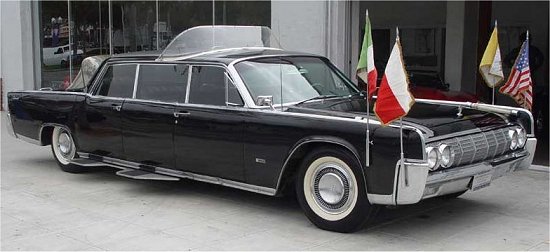
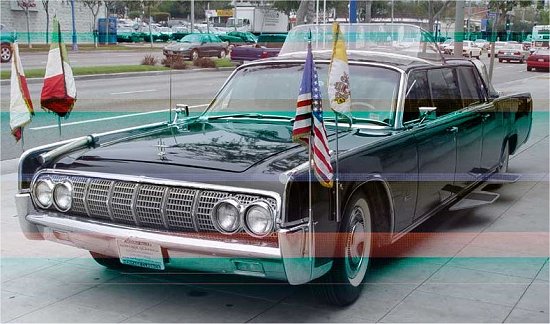
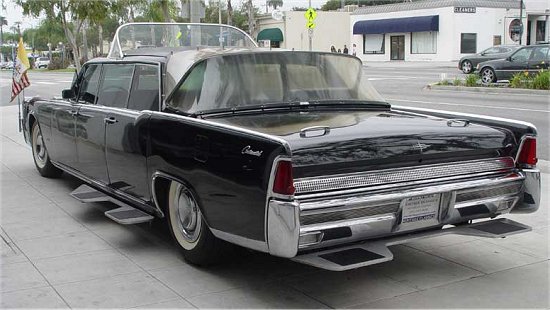
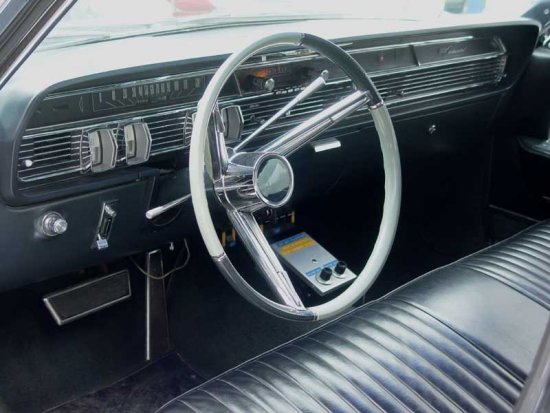
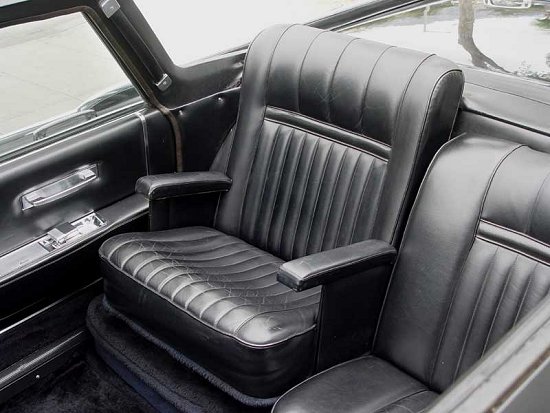
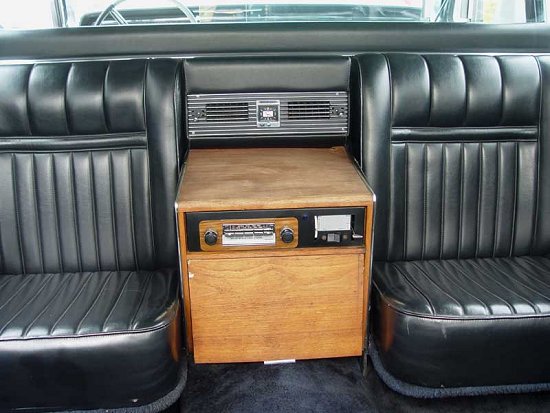
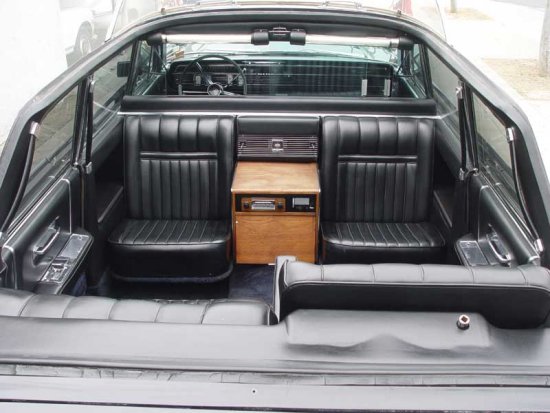
RM Auctions Papal Limousine DescriptionThe Official Papal Limousine Used for Pope Paul VI and celebration parade car for the Apollo 8, 11 and 13 Astronauts. 320 hp 430 cu. in. V8 engine, three-speed automatic transmission, front coil, rear leaf springs, original power assisted four-wheel drum brakes converted to front disc. Wheelbase: 160" The Ford Motor Company’s Lincolns have a long, rich tradition in history of being the favorite conveyances of Presidents, Royalty and potentates. That seems more than appropriate, considering the fact founder Henry Leland selected the name of his company based on his admiration for past President of the United States, Abraham Lincoln. The first Lincoln in the presidential garage at the White House was at the request of Calvin Coolidge shortly after Henry Ford had purchased the Lincoln Motor Car Company in 1922. Lincolns have remained as official White House limousines in subsequent administrations since then. Lincolns in the past have been in service to numerous heads of state, Popes and the royal families of Sweden, Iran, Belgium and the Netherlands. The basis for the Lincoln limousines of the early 1960s was the sensational, new Continental which appeared in 1961. Its classic soft lines were elegant in execution. By 1964 a major facelift was underway to keep the Lincoln flagship fresh and up-to-date. Flat side glass replaced the original curved panes; more than three inches were added to the length –most toward the rear entry, fifteen inch wheels replaced the smaller fourteen inch ones, a new grille and rear taillight design was employed, and a full-length lower trim molding was added. When Pope Paul VI announced he would speak on World Peace at the United Nations in 1965, Ford Motor Company immediately announced they would provide a Papal limousine. It was now up to the Transportation Manager attached to Ford Motor Company’s, New York Public Relations office, Cal Beauregard, to ensure this unique limousine would be ready to roll in just four months time along with an entire motorcade for numerous Cardinals, as well as President Lyndon Johnson and his entire entourage. The initial thinking had been to utilize the full-frame construction of a Ford LTD, but with only weeks to go, Henry Ford II insisted that the limousine be based on the company’s most luxurious and prestigious vehicle – a Lincoln. All the new Lincolns were unibody construction, which were far more complicated to adapt into a “special” limousine in such a short period of time. Lehmann-Peterson were authorized to produce the four-door, eight passenger Executive Limousine based on the Lincoln Continental model 53A, which would be covered by Ford’s factory warranty. Due to the finalizing of all the details there was less than half a month left to construct the Papal Limousine based on the specifications from Rome and the Ford Motor Company, yet George Lehmann and Bob Peterson proved their professional capabilities were up to the task of building this extraordinary one-off vehicle. The only Lincoln available for the almost instant conversion was the 1964 Model 53A prototype constructed by Lehmann-Peterson to demonstrate to Ford Motor Company their expertise, which was the very car that had earned them the contract to build Ford’s special vehicles. With so little time left Ford supplied engineering support as the task involved much more than the mere stretching of a Lincoln Continental. Following the stretching of the wheelbase to 160” with the resulting overall length of 250.3” or almost 21,’ there were many additional features and provisions required. From a security standpoint there was the necessity of fitting running boards at the sides and rear with grab handles for guards. Rather than regular plush seating a specially designed and constructed throne-like Papal chair needed to be fitted with the ability to be raised or lowered depending on the circumstances. Additional seating would be required for the Pope’s aids and Cardinals. Demands for additional electrical systems necessitated a power source separate from the engine. A series of seven batteries were mounted in the trunk to provide the special florescent lighting necessary to illuminate the interior for the crowds to view Pope Paul VI at night. A built-in charger could be accessed via a connection fitted in the right rear quarter panel. A state-of-the-art, on-board, custom-fitted public address system with amplifiers and speaker was also installed. Another essential design feature was a removable bubble top and a second windscreen that could be erected when the limousine was completely open. There was not enough time to mold the customary clear bulletproof bubble top. Instead a top was constructed with clear and solid sections and covered in a transparent, hand-stretched vinyl followed by another protective sheet. There was an advantage to this top with its own structural integrity in that it was very light and could be lifted into place easily. This would prove to be a very important feature during the Pope’s visit. Working around the clock to exact specifications the Papal Limousine was completed in a mere ten days and delivered to New York City on time on October 3, 1965. Perhaps the most memorable occasion for the Papal Lincoln was the evening before his departure for Rome when Pope Paul VI conducted a Mass at Yankee Stadium. The Lincoln – in its open configuration – was used to carry his holiness out past the adoring crowds. Since it was important that the Pope be seen as long as possible, the car remained open, even though it was a cold evening. After the Papal Lincoln entered an exit tunnel in Yankee Stadium, Cal Beauregard, Bob Peterson, and a crew set the clear hardtop in place. Using portable power tools the crew fastened the roof into place as the car drove slowly through the tunnel. The Papal Lincoln emerged outside Yankee Stadium with Pope Paul VI fully enclosed and bathed in a soft light, carrying its precious cargo to his final stop on that tour – a visit to the Vatican Pavilion at the World’s Fair. Following the Pope’s departure the Lincoln was returned to Lehmann-Peterson where the clear top was removed along with the Papal chair and the rest of the interior and fittings and stored. The Papal Lincoln was converted into a Chicago parade and dignitaries vehicle until 1968. In 1968 Cal Beauregard was contacted by Rome asking if the Papal Lincoln could be delivered to Bogotá, Columbia for his worship’s visit to the 39th International Eucharistic Congress. Once again Cal Beauregard and Lehmann-Peterson were under immense pressure to ready and deliver the Papal Lincoln to the New York docks for shipping in a mere 12 days. It was discovered at the warehouse that the roof had collapsed due to winter snow and damaged the Papal interior. The Papal chair was reupholstered in black leather and new black carpeting fitted throughout. The full rearward facing seat was discarded in favor of two individual seats separated by a full console for storage and the installation of the controls for the climate control system. Cal Beauregard and Ford engineers rushed to assist Lehmann-Peterson personnel to meet the deadline. Since Bogotá is 8,000’ above sea level the Lincoln’s V8 engine was specially tuned. Spare parts and tools including a full set of tires mounted on 15” wheels were also assembled for shipping. Beauregard drove the Papal Lincoln to New York City and traveled with the car to Cartagena, Columbia to oversee the delivery. Unloading the Papal limousine proved difficult due to its size and the lack of appropriate equipment. Beauregard then drove the Papal Lincoln to a Columbian Air Force base where it was loaded onto a C-130 and flown 400 miles to Bogotá. After performing its duties impeccably, returning the Papal Lincoln to the United States presented a problem. The head of the military in Columbia confiscated the keys for unknown security reasons. Fortunately, Beauregard had sets of duplicate keys and with the appropriate paperwork was able to fly the Papal car to Howard Air Force Base in Panama. Due to regular outbreaks of Hoof and Mouth disease in Columbia the Lincoln was quarantined for sixty days before being shipped back to the U.S. From the port in New York City the Papal Lincoln was once again returned to Lehmann-Peterson. It was used to carry the Apollo astronauts in ticker-tape parades after their successful flight. In an interview Mr. Beauregard intimated that photographs exist picturing the Apollo 8 crew -Capt. James A. Lovell, Frank Borman, and William Anders, riding in the Papal Lincoln in Chicago, January 1969. Reportedly the Papal Lincoln was subsequently used for parading the Apollo 11 and 13 astronauts as well. Eventually the Papal Lincoln was sold to a prominent ophthalmologist in Fort Dodge, Iowa. This exclusive Lincoln with its illustrious history is believed to have joined an Arizona collection next, before making its way overseas where it spent sixteen years as a prominent display piece in a museum housing vehicles of heads of state just outside Paris, France. The current owner acquired the car from the museum and has recently returned the car to the U.S for the first time in over 16 years. Today the Lincoln remains in absolutely timewarp condition with almost no visible significant wear throughout the car having never been restored. The black paintwork remains all-original and though there are some areas where it has faded only slightly, it remains all the while truly exceptionally well preserved. The interior is equally impressive, as it too has stood the test of time brilliantly with only the expected wear visible with some fading on the leather. The carpeting, all interior brightwork, trim and ancillary details are also in original overall condition and only show light wear from use. The current owner recently had a thorough mechanical service executed on the Lincoln and has related that the Papal Limousine’s mechanical components are all operational and work as one would hope for and expect. The interior is equally impressive, as it too has stood the test of time brilliantly with only the expected wear visible with some fading on the leather. The carpeting, all interior brightwork, trim and ancillary details are also in original overall condition and only show light wear from use. The current owner recently had a thorough mechanical service executed on the Lincoln and has related that the Papal Limousine’s mechanical components are all operational and work as one would hope for and expect. Without question, the Lincoln offered here remains as one of the most historically significant examples of its kind and RM Auctions is delighted to present this timewarp original Papal Limousine, with its excellent provenance and owner history, at the 2006 Monterey Sports and Classic Car Auction. For further information on this special one-off Lehmann-Peterson coachbuilt example please do not hesitate to contact a member of RM Auctions motor car specialists. Originally conceived to transport Pope Paul VI during his visit to New York in October of 1965 and built on the 1964 Lincoln Prototype 53A, Lehmann-Peterson customized the Limousine to meet Papal requirements in just 10 days. The special features on this car include extended running boards and grab handles for security personnel, a throne like Papal chair that could be lowered and raised, flood lights to illuminate the pope from the interior, as well as an onboard speaker system for addressing crowds. Most notably it features an open canopy top with a flying-bridge type windscreen for when the bubble top was not in place. Today the Limousine remains in exceptional timewarp condition with all its original Papal modifications including even the official Vatican flags. |
